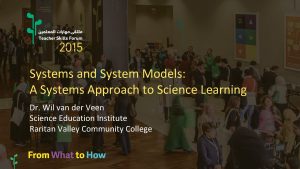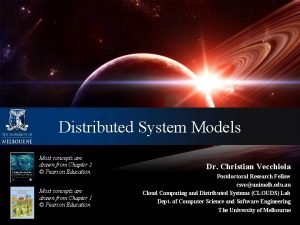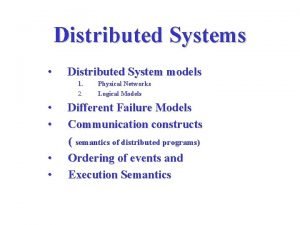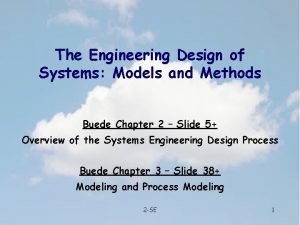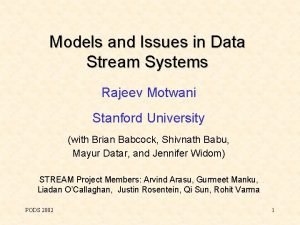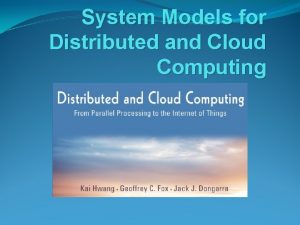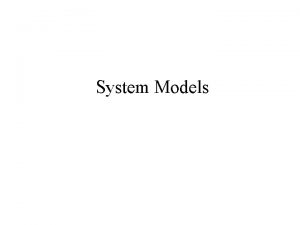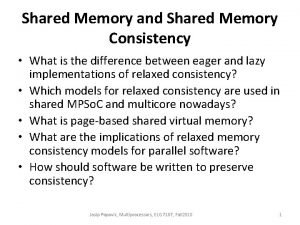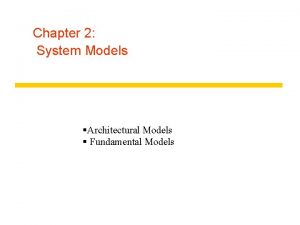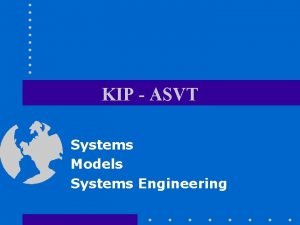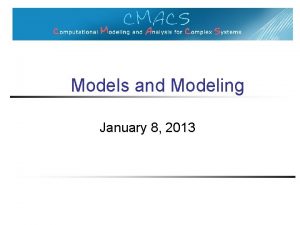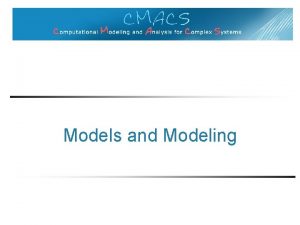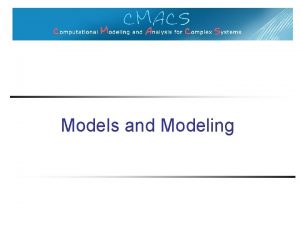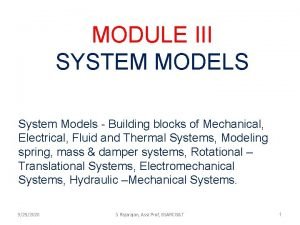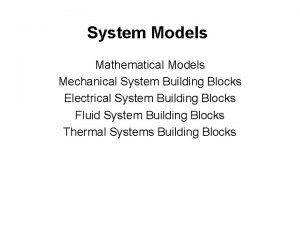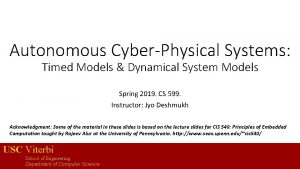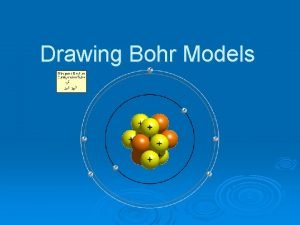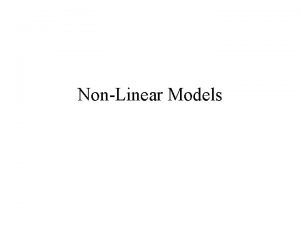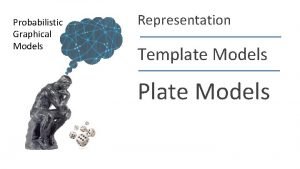Systems and System Models A Systems Approach to



















- Slides: 19

Systems and System Models: A Systems Approach to Science Learning Dr. Wil van der Veen Science Education Institute Raritan Valley Community College

The Next Generation Science Standards A New Vision for Science Teaching and Learning 2 Systems and System Models A Systems Approach to Science Learning

The NGSS were Developed Based on a Framework • The NGSS were developed based on a Framework for K-12 Education published by the National Academies. • The NGSS incorporate our best understanding of how students learn science. • The NGSS take into account the needs of the 21 st Century workplace. 3 Systems and System Models A Systems Approach to Science Learning

Key Idea of the Framework and the NGSS Crosscutting Concepts Practices Students should know and able to use and apply: • Science & Engineering Practices • Crosscutting Concepts • Disciplinary Core Ideas 4 Core Ideas Systems and System Models A Systems Approach to Science Learning

Crosscutting Concepts 1. Patterns 2. Cause and Effect 3. Scale, Proportion, and Quantity 4. Systems and System Models 5. Energy and Matter 6. Structure and Function 7. Stability and Change In your Journal describe how you have addressed one of these crosscutting concepts with your students. 5 Systems and System Models A Systems Approach to Science Learning

NGSS Appendix G Crosscutting Concepts Read pages 1 and 2 until Guiding Principles. • The purpose of crosscutting concepts is to deepen students understanding of core ideas. • Crosscutting concepts are not new! • Crosscutting Concepts have to be made explicit. 6 Systems and System Models A Systems Approach to Science Learning

Why are Systems and System Models so Important? • All interactions involve at least 2 objects – a system. • The universe is very large and we only study small parts of it at a time. 7 From NSTA webinar: Systems and System Models by Ramon Lopez Systems and System Models A Systems Approach to Science Learning

Hierarchy of Systems • Galaxies, Solar System • Earth Systems, Ecosystems • Macroscopic Systems • Atomic-Molecular Systems • Subatomic Systems • Nuclear Systems 8 Adapted from NSTA webinar: Energy and Matter by Charles Anderson and Joyce Parker Systems and System Models A Systems Approach to Science Learning

What are the Features of a System? 1. Boundaries Surroundings Boundary System 2. Components 3. Flows and Interactions 9 Adapted from NSTA webinar: Systems and System Models by Ramon Lopez Systems and System Models A Systems Approach to Science Learning

Natural Phenomenon Ice Cubes in a Cup of Water Discuss the following question with your table group: • What are the boundaries of the system? • What are the parts of the system? • What are the interactions and flows? 10 Systems and System Models A Systems Approach to Science Learning

System Models Ice Cubes in a Cup of Water Draw a model to represent the system. • Represent the boundaries, components, interactions and flows. • Use text and symbols. 11 Systems and System Models A Systems Approach to Science Learning

Crosscutting Concepts Discuss the following questions with a partner: • Which other Crosscutting Concepts did you use to make sense of this phenomenon? • How are these Crosscutting Concepts connected? 12 Systems and System Models A Systems Approach to Science Learning

Crosscutting Concepts Cause and Effect Structure and Function Patterns Scale Systems 13 Change and Stability Matter and Energy Systems and System Models A Systems Approach to Science Learning

NGSS Appendix G: Crosscutting Concepts Appendix G, page 2: • Crosscutting concepts can help students better understand core ideas in science and engineering. • Crosscutting concepts can help students better understand science and engineering practices. • Repetition is necessary to build familiarity with crosscutting concepts. • Crosscutting concepts should grow in complexity and sophistication across the grades. 14 Systems and System Models A Systems Approach to Science Learning

Systems and System Models • Use your Journal and list what you think your students should know about Systems and System Models and what they should be able to do. • Read the descriptive text on page 3 of NGSS Appendix G. • Look under Progression Across Grades what students should be able to know about Systems and System Models and students should be able to do at your grade level. • Add to the ideas in your Journal. 15 Systems and System Models A Systems Approach to Science Learning

Natural Phenomenon Large Number of Dead Fish in a Lake Group Performance Tasks: • Develop a model of the relevant ecological system to illustrate possible causes for why there are dead fish in the lake. • Use the model to develop questions to focus the gathering of additional information from various sources (including online). 16 Systems and System Models A Systems Approach to Science Learning

Natural Phenomenon Large Number of Dead Fish in a Lake Group Performance Tasks: • Develop a model of the relevant ecological system to illustrate possible causes for why there are dead fish in the lake. • Use the model to develop questions to focus the gathering of additional information from various sources (including online). Instructional scaffold: • What is the boundary of the system that we need to consider when investigating this phenomenon? • What are the components? • What are the interactions and flows? • What are some possible causes? • What additional data or information do you need? 17 Systems and System Models A Systems Approach to Science Learning

Final Reflection • Write down one thing you could change in your classroom based on what you experienced in this workshop. • Share with a partner. 18 Systems and System Models A Systems Approach to Science Learning

Other Related Sessions Friday (Full-day Institute) • Moving Past Memorization: Applying Science Concepts to Explain the Natural World Saturday (1. 5 -hour workshop) • System and System Models: A Systems Approach to Science Learning Sunday (1. 5 -hour workshop) • Energy and Matter: Helping Students Distinguish Between Matter and Energy 19 Moving Past Memorization: Applying Science Concepts to Explain the Natural World.
 Systems and system models
Systems and system models Modals and semi modals difference
Modals and semi modals difference Fundamental model of distributed system
Fundamental model of distributed system Physical model in distributed system
Physical model in distributed system Virtual circuits and datagram networks
Virtual circuits and datagram networks Tony wagner's seven survival skills
Tony wagner's seven survival skills The engineering design of systems: models and methods
The engineering design of systems: models and methods Models and issues in data stream systems
Models and issues in data stream systems Cognitive approach vs behavioral approach
Cognitive approach vs behavioral approach Waterfall strategy in international marketing
Waterfall strategy in international marketing Multiple approach avoidance
Multiple approach avoidance Cognitive approach vs behavioral approach
Cognitive approach vs behavioral approach What is research
What is research Approach to system development
Approach to system development All resources are tightly coupled in computing paradigm of
All resources are tightly coupled in computing paradigm of Service ade 9500 systems
Service ade 9500 systems Modern system analysis and design
Modern system analysis and design A modern approach to systems analysis and design
A modern approach to systems analysis and design Memory consistency
Memory consistency Open closed isolated system
Open closed isolated system
